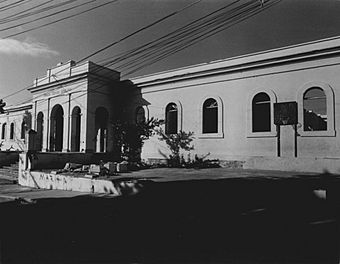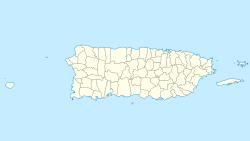Antiguo Hospital Militar Español de Ponce facts for kids
Quick facts for kids |
|
|
Antiguo Hospital Militar Español de Ponce
|
|
 |
|
| Location | Calle Bondad, between Calle Atocha and Calle León Ponce, Puerto Rico |
|---|---|
| Area | 1 acre (4,000 m2) |
| Built | 1896-97 |
| Architect | Spanish Royal Corps of Engineers |
| Architectural style | Neoclassical architecture |
| MPS | 19th Century Civil Architecture in Ponce TR |
| NRHP reference No. | 87000770 |
The Antiguo Hospital Militar Español de Ponce (which means Old Spanish Military Hospital in Ponce in English) is a very old and important building in Ponce, Puerto Rico. It's located in the city's historic area. This building was finished in 1896 or 1897. It was designed by a group of engineers from Spain called the Spanish Royal Corps of Engineers.
The building shows off the Neoclassical architecture style from the 1800s. This style uses ideas from ancient Greek and Roman buildings, like columns and simple, grand designs. This hospital is special because it's the only one-story building of its kind left in Ponce. It's also one of the best examples of this style on the whole island of Puerto Rico. It was the last big building project the Spanish government completed in the Americas before the Spanish–American War in 1898. From 1905 until the mid-1970s, it was used as the Asilo de Ciegos de Ponce, which means the Ponce Blind Asylum. As of 2025, the building is empty and not being used.
Contents
A Look Back: The Hospital's Story
This building, often called the Asilo de Ciegos (Home of the Blind), was built between 1896 and 1897. Its first job was to be a hospital for the Spanish soldiers stationed in Ponce. The Royal Spanish Engineering Corps built it in the popular Neoclassic style. This style was common in old San Juan but not as much in Ponce at that time.
This building, along with El Castillo (Ponce's Spanish military headquarters), Hospital Tricoche (Ponce's Municipal Hospital), and the Casa Alcaldía (City Hall), are the only buildings left that show how much the Spanish Crown cared about other parts of the island, not just San Juan.
On October 1, 1905, the building got a new purpose. It became the Asilo de Ciegos de Ponce, a home for blind adults in the city. It stayed open as a home for the blind until the mid-1970s, when it closed. It had enough space for 95 people. In the early 1910s, about 80 people lived there regularly.
As a home for the blind, it offered medical help, including eye surgeries. Dr. Guillermo Vives performed many successful operations there. He helped about 95% of his patients get their eyesight back. The asylum also taught blind residents skills to help them live on their own. For those who couldn't care for themselves, it provided a permanent home.
Why This Building is Special
This building is very important for its architecture. It's the only one-story building of its kind left in Ponce. It's also considered one of the best examples of its style in all of Puerto Rico.
First, it served the military in Ponce and the southern region. It could also be used by regular people during emergencies or natural disasters. This helped meet a big need for healthcare in the southern part of the island.
Later, in 1905, the building was given to the state government to be used as an asylum for the blind. It gave shelter to many poor blind people in the south. Here, they learned skills that could help them support themselves in the future. For those who couldn't be helped to live independently, the asylum provided a safe home and free meals. This kept them off the streets where they might be in danger. The important social work done in this building continued until the mid-1970s when it closed. People in Ponce believe this building is a key part of their community's history because of its role as both a hospital and an asylum.
What Does It Look Like?
This one-story building is a great example of the Neoclassic style in Ponce. It's the only single-story building of this type in the area. It still has its simple, strong design, which was common for military or official buildings in the 1800s.
Some of its special features include its thick, solid outer walls and flat columns called pilasters. These pilasters have simple tops called tuscan order capitals. The windows have flat frames around them. A set of steps leads up to the main entrance, which sticks out from the front of the building. A simple decorative strip, called a cornice, runs along the top of the building on all sides. There are many arched windows that originally had wooden shutters and glass panels above them. These windows were replaced with metal blinds in the mid-1960s and have been damaged recently.
The main entrance is a standout feature. It has a large central arch with two smaller arches on its sides. These arches and two other side arches are decorated with Tuscan-style pilasters. Four Tuscan pilasters, a simple flat band (frieze), a cornice, and a low wall (parapet) complete the entrance's decoration. This makes the entrance look a little taller than the rest of the building.
The building was built around a rectangular central patio (courtyard). This courtyard has arched walkways on all sides. These walkways connect to the offices and rooms located around the outside, which was typical for buildings of this time and style. A small fountain used to be in the center of the patio, providing both decoration and water. This fountain is no longer there.
The building was made from brick and a mix of rubble and stone. Thick walls, placed evenly, support wooden beams. These beams were likely made from strong Puerto Rican wood like ausubo. These beams hold up the brick roof. This building also has a basement on its south side, which is unusual for this type of construction.
Many windows, parts of the roof, and wooden sections have been damaged by vandals in recent years because the building has not been used. However, the main parts of the building's structure and its decorations are in good condition or could be fixed. The building is not currently in use and is not open to the public.
See also


